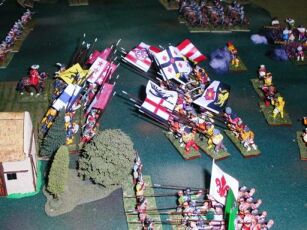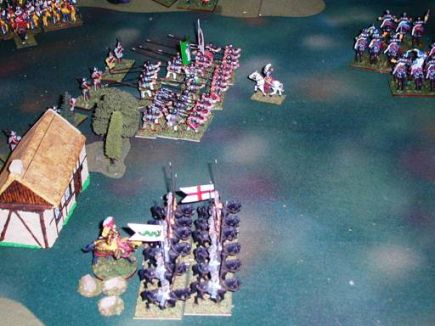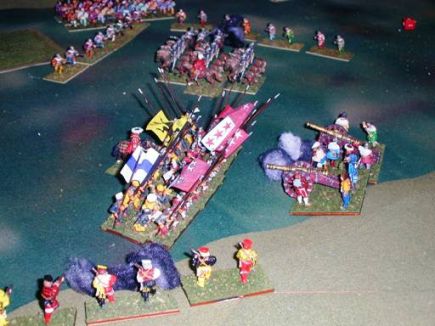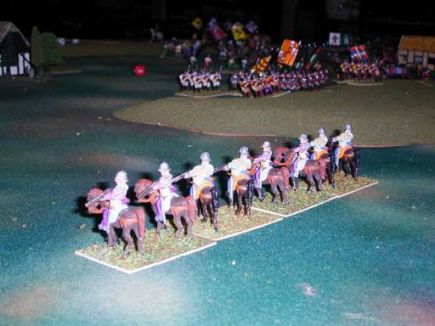The Empire Strikes Back: The Battle of Ceresole, April 14, 1544
Information and Resources Related to Piquet - Band Of Brothers 2nd Edition
Home :: About Peter :: About Band Of Brothers :: Battle Reports :: Gallery :: Contact
The Empire Strikes Back: The Setting
The French are at it once again in Northern Italy! Now they are in control of central Piedmont, centered upon Turin. King Francis has appointed a prince of the royal blood, Francis Bourbon, Lord of Enghien, to command his forces. Enghien besieged the stronghold of Carignano starting in late winter. The town was strongly defended by some of the Empire's best troops under Pietro Colonna. Anticipating that the siege would compel the Imperialists to offer battle, Enghien sent Montluc to Paris to ask permission to offer battle. The King and his advisors reply that battle may be offered if a council of war convened in the field agrees. Said council being held and the decision to offer battle confirmed, the two armies meet in a clash of arms. The Imperialists are stronger in infantry and the French stronger in cavalry. The Imperialist cavalry are mostly composed of the new Pistol packing Reiters.
Deployment
The two armies have deployed opposite one another along two low ridges. They have exchanged an ineffective artillery bombardment for several hours, but now both armies see that they must advance and engage in battle if they are to accomplish their objectives.

In order from the Imperialist right flank to left:
Imperialists: Jose Del Vasto Commander in Chief; Ramon de Cardona (Right wing), Carlo Gonzaga (Cavalry), Aldobrand Madrazzo (Landsknechts)
- MC Cavalry Stradiots (8)
- Spanish Pikes/Arquebsuiers (Tercio) (32 pikes/24 Arquebusiers)
- Spanish LI Musketeers (8)
- Medium Artillery (6)
- German Reiters (12)
- Landsknecht Pikes (36)
- Landsknecht LI Arquebusiers (8)
- Salerno Italian Pikes (36)
- Salerno Italian LI Arquebusiers (8)
- Italian MI Arquebsuiers (12)
- Florentine Extra Heavy Cavalry (Reiters) (12)
French: Francis Bourbon, Lord of Enghien; Barre des Thermes (Right Wing Cavalry), Dampierre (Center), Sieur Descroz (French/Italian)
- LC Arquebusiers (8)
- Italian Infantry (Pikes) (36)
- Italian Arquebusiers (8)
- French Pikes (36)
- French Arquebusiers (8)
- Medium Artillery (6)
- Swiss Pikes (36)
- Swiss LI Arquebusiers (8)
- French HC Chevaulegers #1 (12)
- French Gendarmerie 1 (12)
- French Gendarmes 2 (12)
- French HC Chevaulegers #2 (12)
The Battle
As the wind began to clear the dense clouds of acrid black smoke from the valley between their positions, Francis Bourbon, Prince of the blood royal and titular Lord of Enghien, surveyed the fields that would soon run red with the blood of brave men of many nations. The morning's cannonade had produced precious little results, and action was clearly needed if there was to be any chance of a decisive action. In addition, the Nobles who had attached themselves to his army were beginning to become restless at the inactivity, and were clamoring for an advance upon the foe. Very well, he sighed, it is time. Turning to his trumpeter, he motioned to hi to sound the advance. The Prince planned to advance with his strong right flank, expecting his Gendarmes and Lancers, lead by Barre des Thermes, to make short work of the newfangled Pistol packing Reiters of the enemy. His left flank he would hold back... no reason to hasten the confrontation with the deadly Tercio opposite! Let the walking fortress lumber forwards towards him while his guns pounded away at it the whole long way.
Across the valley, Jose del Vasto also watched the smoke clear. He was acutely aware of his inferiority in cavalry, and that made him cautious. His arquebusiers were excellent, however, and his Tercio unmatched. He would advance with his right flank, including the Tercio of Leon. Seeking to make the best use of his firepower, Jose opted to hold his own left flank back. Satisfied with his battle plan, he trotted off to accompany his sole reserve, the Imperial Reiters.
At first, both sides seemed somewhat reluctant to act, but ultimately it proved to be the French who were more eager to close with the enemy. Des Thermes lead his cavalry in a bold advance upon the Imperialist left flank, seeking to overwhelm the sole unit of enemy Reiters with both superior numbers and quality. In support of this maneuver, the Swiss pikes and the cavalry of the French center under the Chevalier Dampierre advanced as well. Unfortunately, as the French cavaly descended from the hill, the Imperialist artillery sited opposite them in the valley fired with commendable precision and laid low many of the aristocratic troopers. Nor did the horsemen of the Barre des Thermes fare much better. As they neared the French left flank, the Gendarmerie came under intense and accurate fire by the Landsknecht arquebusiers, throwing them into marked disorder and emptying more than a few saddles. Aldobrand Madrazzo, commanding the Imperialist left, cheered and called upon the serried ranks of the nearby Italian Arquebusiers to hold their fire in order to complete the discomfiture of the flower of French Society. However, the Italians had been but recently raised and lacked any supporting pikemen, and upon viewing the imposing mass of horseflesh thundering down upon their position, decided that discretion was clearly the better part of valor. The militiamen broke and ran for the rear, never stopping nor looking back once until the sun faded from the sky that evening! Feeling encouraged by these events, the supporting French chevaulegers charged home upon the Florentine EHC Reiters.

Well trained and well armed with three pistols apiece, the Florentines discharged their firearms into the charging lancers, killing one of the standard bearers and sowing disorder throughout their ranks. As the charge lost impetus and wavered, the pistoliers frantically reloaded, firing by rotation as their attackers milled around indecisively. Slowly, imperceptibly, the French cavalrymen wavered and then broke! Another salvo from the highly skilled Landsknecht Arquebusiers then slammed into the Gendarmes who were milling around in the beaten zone of the marksmen. Their ranks decimated, the vaunted chivalry of France I turn streamed to the rear!
"Quel desastre!" moaned Enghien.. His powerful cavalry wing in ruins, the prospects for victory on the day were looking dim indeed. Just then the Gendarmes of his own central reserves were struck by another salvo from the distressingly accurate Imperialist guns across the shallow valley separating the infantry, shredding men and horses in a fashion awful to behold. Curse that obscure priest who had first discovered that devil's mix! Gunpowder disrupted the social order ordained by God by allowing mere commoners to face their betters on the field of battle as their equals. Shaking off his melancholy, the Prince of the blood Royal sent a page galloping of to the Chevalier Dampierre, urging him to press the advance with the Swiss pikes, the best remaining troops in the French army.

Across the shallow valley, Jose del Vastro smiled faintly at the progress of the battle so far. Three of the four units of the fearsome French cavalry had been destroyed or shattered, and, amazingly, his own remained largely untouched. His infantry, as a whole, should prove more than a match for the weaker arm of the French host. It was time to shift to the offensive. He swiftly dispatched messengers to Ramon de Cardona to set the right wing and its massive Tercio in motion, and to Madrazzo to advance in support of Gonzaga's victorious cavalry. As they cantered across the battlefield, Del Vastro heard a roar from the French guns and the cries of the wounded as the enemy artillery finally found the range on the Tercio of Leon. Although there were losses, the huge formation seemed only little more affected than a seaside cliff is by the pounding of the surf upon it. It would take much more pounding than that to grind it slowly to sand!

Still, it did seem best to give the French Gunners something to think about besides gleefully pounding away at the finest target to be found on a Renaissance battlefield! The wild Albanian Stradiots, notorious looters and pillagers all, seemed best suited to the task. They trotted forwards, challenging their opposition, the French mounted arquebusiers, for dominance of the Imperialist far right. As the Stradiots advanced, the mounted arquebusiers fell back before them. They had superior firepower, but were at a considerable disadvantage should the Stradiots close to hand to hand combat. Sensing a shift in the initiative in their favor, the Stradiots used the mobility of a native to wheel in towards the center of the battlefield! The mounted arquebusiers had a glorious target should they only be able to close the range to take advantage of it! However, fortune favored the wild horsemen form the Balkans, and they swept across the front of the French battle line, dodging the wildly inaccurate fire of the foot arquebusiers attached to the Italian pikes and taking the French guns in flank.

The result was a foregone conclusion, and the gunners were soon fleeing the field, leaving their precious ordinance far behind. In retaliation, the Italian pikes charged home on the recently victorious Stradiots, dispersing them handily. The Stradiots played no further role in the battle, but they had done their job; the guns silenced, the Tercio could now advance without fear. And advance it did!
Meanwhile back on the Imperial left flank, the Italian infantry and the victorious Florentine Reiters began their own advance, threatening to turn the right flank of the French army. Their turning movement was somewhat hampered by the Frandsini farmstead, which gave partial protection to the now vulnerable French. Seeing the threat, the Chevalier Dampierre redirected the now artillery battered Lancers from his center to protect his vulnerable flank from the enemy Reiters... the Gendarmes of the center had long since succumbed to the galling fire of the Imperialist guns and were no longer an effective fighting force. Before long, this resulted in a standoff between the two bodies of cavalry, which was broken when the Lancers charged impetuously into the Reiters, with the Lord of Enghien at their head!

Discharging their loaded pistols into the teeth of the oncoming Lancers, the Reiters created a dense cloud of acrid smoke, akin to the products of the Inferno. This time however, the losses the caracoling pistoliers inflicted were failed to truly challenge the determination of the Frenchmen. The two bodies of horse collide with a thwack that was heard all across the battlefield! Although substantially outnumbered, the shock of the Lancer's charge was irresistible, and the now unloaded Reiters were served up en brouchette, much to the delight of the French Prince. Maybe it wasn't going to be such a bad day after all?
Meanwhile, the veteran Swiss pike block was closing upon that of the Imperialist Landsknechts. The Swiss, eager to come to push of pike, advanced silently but with alacrity. The Landsknechts in turn moved forwards rather more cautiously, while bellowing out their famed war chant, "Hoch, dich, heir komm ich! "

Back in the center of the battlefield, the Tercio of Leon was lumbering forward to challenge the contingent of allied Italian infantry stationed opposite them, with the Imperial Reiters now trotting forth in support. The militia troops were now match for the veteran Tercio, and were soon put to rout by the superior fighting ability of the professional Spanish soldiery.

As the Swiss advanced upon the enemy Landsknechts, the Imperial Reiters trotted forward in caracole formation, trying to threaten their left flank. Perceiving the threat, the Sieur Descroz bade his 2 units of arquebusiers to entertain the Imperialist cavalry with their firepower. This was done, but most of the merriment revolved around the ineffectiveness of said fire. In order to reinforce the threat, the French pikes also moved up in support of their brethren with firearms.

Indeed the battle soon turned in to one of threat and counter threat, almost no flank being secure, except of course, the fortress-like Tercio! The Florentine infantry fighting for the empire wheeled past the Frandsini farm, and in turn the sparse but victorious ranks of the French Lancers swung out from behind the same farm to threaten the rear of the Florentines.

As this elaborate minuet played itself out on the French right flank, the Swiss, having little taste for the muses but far more for combat, charged home on the Imperial Landsknechts. The Swiss Forlon Hope was commited to the action, and chopped off pike heads and generally disordered the formation of the Landsknechts. In a few minutes the entire Imperial pike block was running for the rear, enacting a parody of their battle cry. "Look out, you, here I come!" indeed!
Scarcely bothering to reorder their unformed ranks, the Swiss pressed on with the goal of slaughtering the hated Imperialist gunners who had so severely harmed the cause of French arms that day. A not inconsiderable advantage of this aggressive approach was that it also opened up the distance between themselves and the Florentine infantry, who were situated uncomfortably close to the rear of the Swiss. Shaking off fire from the supporting Landsknecht arquebusiers and the guns themselves, the dour Swiss dove into the hapless artillerists like a drunken sailor into a trollop! Once again, the issue was hardly in doubt as the crew broke and ran, leaving their guns behind, silent and ineffective.

It was to be the last hurrah for French arms that day, however. The initiative passed to the Imperialists, and the Tercio drew a bead upon the nearby French infantry, whilst the Florentine infantry closed the gap between them and the rear of the now disordered Swiss. The chips were finally down for the French. Recognizing the inevitable, Francis Bourbon, Lord of Enghien and Prince of the Blood Royal, gave the order to sound the retreat. "At least those heretofore ineffective mounted Arquebusiers can be put to good use covering the retreat of the army!" the disheartened Enghien was heard to mutter.

Game Notes
This battle, played here in Bridgewater on May 20, 2006, was based upon the Battle of Ceresole. Joe had the Imperialists, while Barry Frandsen assisted me with the French, commanding the ill fated cavalry wing on the French right. I found Barry's name in the HMGS directory a few months ago... another wargamer in my little town of 1500 people. How cool is that? Hopefully he wasn't too shell shocked by the misadventures of his troops... Barry was certainly a good sport about it!
I took the liberty of replacing the Imperialist cavalry with Reiters. The Imperial army was severely deficient in cavalry compared to the French, but its infantry was both more numerous and of better overall quality. In the actual battle, the lack of cavalry on the Imperial side proved decisive. Here, the effective fire of the Imperial Guns and arquebusiers really took the French cavalry out of the action very early on (Uncontrolled Advance cards spurred the French on.). The endgame of this battle was very up in the air until the final impetus roll, which sealed the fate of the French. The game saw almost all of the additions to BoB2 in use; personal command, unformed status, skirmisher fire and losses, Pike Block, Tercio, and Caracole formations, Courage checks, Cavalry Morale challenges, and the optional Major Morale Check rule.
A lot of recently painted troops saw their first action in this battle. Maybe that accounts for all the units that routed! I'll be running this scenario at Historicon in July, as part of my three ring circus games with BoB2, Renaissance War College 2. This particular game will be one of the three run at 7PM on Thursday, with another 3 different games on Saturday at 12 Noon. Hope to see many of you there!